Critical Analysis: The Art of Argument
VerifiedAdded on 2022/08/17
|8
|3548
|13
AI Summary
Contribute Materials
Your contribution can guide someone’s learning journey. Share your
documents today.
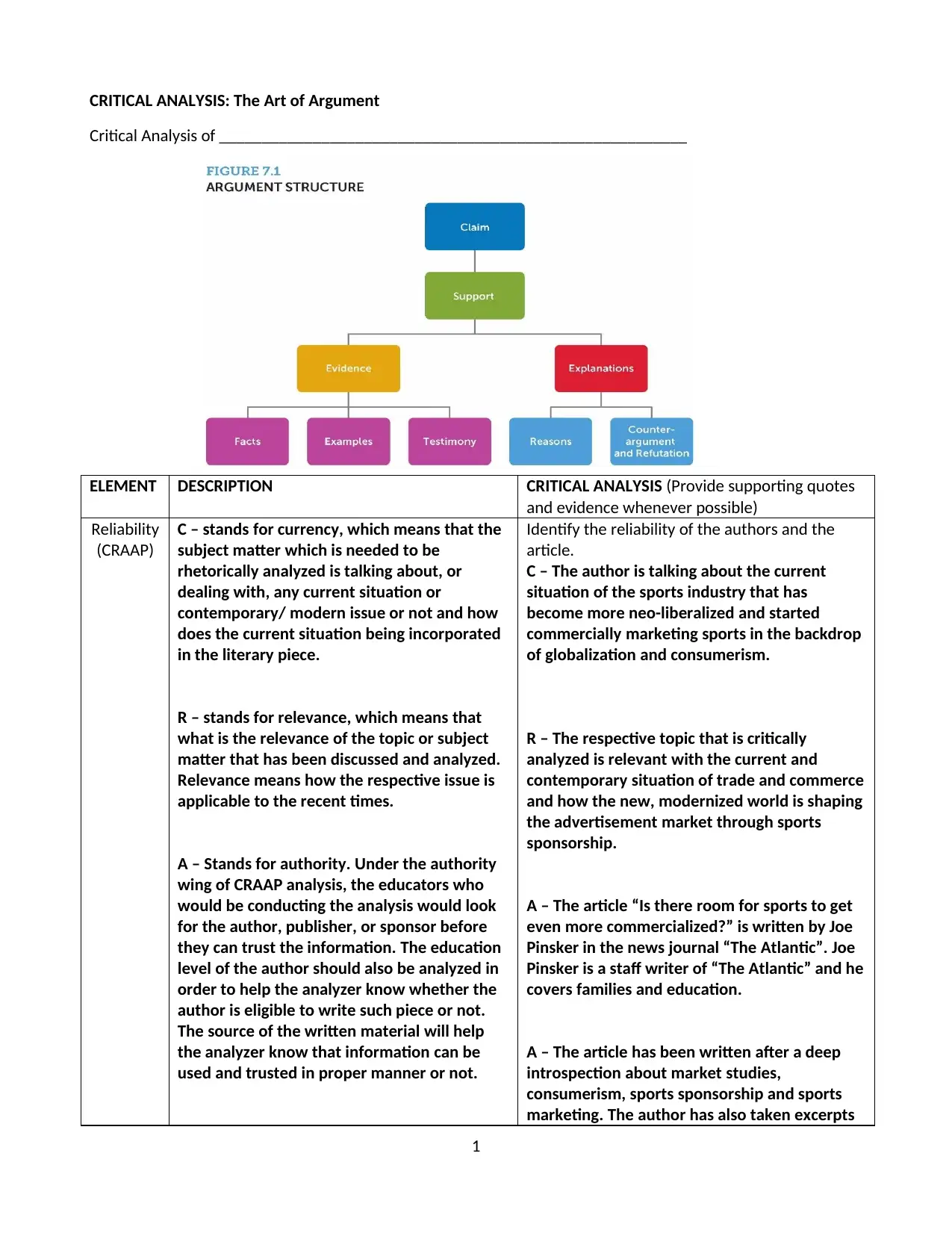
CRITICAL ANALYSIS: The Art of Argument
Critical Analysis of _______________________________________________________
ELEMENT DESCRIPTION CRITICAL ANALYSIS (Provide supporting quotes
and evidence whenever possible)
Reliability
(CRAAP)
C – stands for currency, which means that the
subject matter which is needed to be
rhetorically analyzed is talking about, or
dealing with, any current situation or
contemporary/ modern issue or not and how
does the current situation being incorporated
in the literary piece.
R – stands for relevance, which means that
what is the relevance of the topic or subject
matter that has been discussed and analyzed.
Relevance means how the respective issue is
applicable to the recent times.
A – Stands for authority. Under the authority
wing of CRAAP analysis, the educators who
would be conducting the analysis would look
for the author, publisher, or sponsor before
they can trust the information. The education
level of the author should also be analyzed in
order to help the analyzer know whether the
author is eligible to write such piece or not.
The source of the written material will help
the analyzer know that information can be
used and trusted in proper manner or not.
Identify the reliability of the authors and the
article.
C – The author is talking about the current
situation of the sports industry that has
become more neo-liberalized and started
commercially marketing sports in the backdrop
of globalization and consumerism.
R – The respective topic that is critically
analyzed is relevant with the current and
contemporary situation of trade and commerce
and how the new, modernized world is shaping
the advertisement market through sports
sponsorship.
A – The article “Is there room for sports to get
even more commercialized?” is written by Joe
Pinsker in the news journal “The Atlantic”. Joe
Pinsker is a staff writer of “The Atlantic” and he
covers families and education.
A – The article has been written after a deep
introspection about market studies,
consumerism, sports sponsorship and sports
marketing. The author has also taken excerpts
1
Critical Analysis of _______________________________________________________
ELEMENT DESCRIPTION CRITICAL ANALYSIS (Provide supporting quotes
and evidence whenever possible)
Reliability
(CRAAP)
C – stands for currency, which means that the
subject matter which is needed to be
rhetorically analyzed is talking about, or
dealing with, any current situation or
contemporary/ modern issue or not and how
does the current situation being incorporated
in the literary piece.
R – stands for relevance, which means that
what is the relevance of the topic or subject
matter that has been discussed and analyzed.
Relevance means how the respective issue is
applicable to the recent times.
A – Stands for authority. Under the authority
wing of CRAAP analysis, the educators who
would be conducting the analysis would look
for the author, publisher, or sponsor before
they can trust the information. The education
level of the author should also be analyzed in
order to help the analyzer know whether the
author is eligible to write such piece or not.
The source of the written material will help
the analyzer know that information can be
used and trusted in proper manner or not.
Identify the reliability of the authors and the
article.
C – The author is talking about the current
situation of the sports industry that has
become more neo-liberalized and started
commercially marketing sports in the backdrop
of globalization and consumerism.
R – The respective topic that is critically
analyzed is relevant with the current and
contemporary situation of trade and commerce
and how the new, modernized world is shaping
the advertisement market through sports
sponsorship.
A – The article “Is there room for sports to get
even more commercialized?” is written by Joe
Pinsker in the news journal “The Atlantic”. Joe
Pinsker is a staff writer of “The Atlantic” and he
covers families and education.
A – The article has been written after a deep
introspection about market studies,
consumerism, sports sponsorship and sports
marketing. The author has also taken excerpts
1
Secure Best Marks with AI Grader
Need help grading? Try our AI Grader for instant feedback on your assignments.
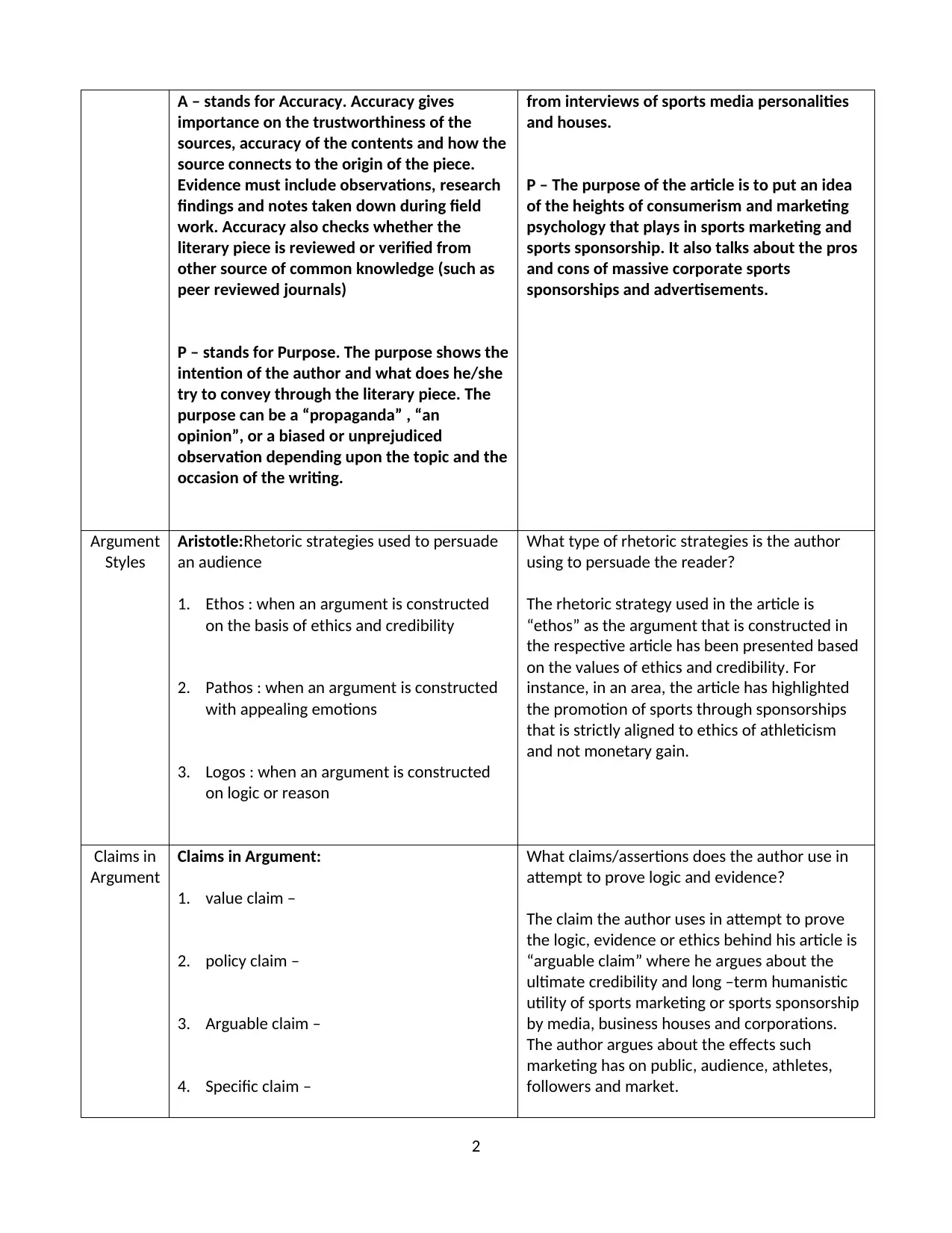
A – stands for Accuracy. Accuracy gives
importance on the trustworthiness of the
sources, accuracy of the contents and how the
source connects to the origin of the piece.
Evidence must include observations, research
findings and notes taken down during field
work. Accuracy also checks whether the
literary piece is reviewed or verified from
other source of common knowledge (such as
peer reviewed journals)
P – stands for Purpose. The purpose shows the
intention of the author and what does he/she
try to convey through the literary piece. The
purpose can be a “propaganda” , “an
opinion”, or a biased or unprejudiced
observation depending upon the topic and the
occasion of the writing.
from interviews of sports media personalities
and houses.
P – The purpose of the article is to put an idea
of the heights of consumerism and marketing
psychology that plays in sports marketing and
sports sponsorship. It also talks about the pros
and cons of massive corporate sports
sponsorships and advertisements.
Argument
Styles
Aristotle:Rhetoric strategies used to persuade
an audience
1. Ethos : when an argument is constructed
on the basis of ethics and credibility
2. Pathos : when an argument is constructed
with appealing emotions
3. Logos : when an argument is constructed
on logic or reason
What type of rhetoric strategies is the author
using to persuade the reader?
The rhetoric strategy used in the article is
“ethos” as the argument that is constructed in
the respective article has been presented based
on the values of ethics and credibility. For
instance, in an area, the article has highlighted
the promotion of sports through sponsorships
that is strictly aligned to ethics of athleticism
and not monetary gain.
Claims in
Argument
Claims in Argument:
1. value claim –
2. policy claim –
3. Arguable claim –
4. Specific claim –
What claims/assertions does the author use in
attempt to prove logic and evidence?
The claim the author uses in attempt to prove
the logic, evidence or ethics behind his article is
“arguable claim” where he argues about the
ultimate credibility and long –term humanistic
utility of sports marketing or sports sponsorship
by media, business houses and corporations.
The author argues about the effects such
marketing has on public, audience, athletes,
followers and market.
2
importance on the trustworthiness of the
sources, accuracy of the contents and how the
source connects to the origin of the piece.
Evidence must include observations, research
findings and notes taken down during field
work. Accuracy also checks whether the
literary piece is reviewed or verified from
other source of common knowledge (such as
peer reviewed journals)
P – stands for Purpose. The purpose shows the
intention of the author and what does he/she
try to convey through the literary piece. The
purpose can be a “propaganda” , “an
opinion”, or a biased or unprejudiced
observation depending upon the topic and the
occasion of the writing.
from interviews of sports media personalities
and houses.
P – The purpose of the article is to put an idea
of the heights of consumerism and marketing
psychology that plays in sports marketing and
sports sponsorship. It also talks about the pros
and cons of massive corporate sports
sponsorships and advertisements.
Argument
Styles
Aristotle:Rhetoric strategies used to persuade
an audience
1. Ethos : when an argument is constructed
on the basis of ethics and credibility
2. Pathos : when an argument is constructed
with appealing emotions
3. Logos : when an argument is constructed
on logic or reason
What type of rhetoric strategies is the author
using to persuade the reader?
The rhetoric strategy used in the article is
“ethos” as the argument that is constructed in
the respective article has been presented based
on the values of ethics and credibility. For
instance, in an area, the article has highlighted
the promotion of sports through sponsorships
that is strictly aligned to ethics of athleticism
and not monetary gain.
Claims in
Argument
Claims in Argument:
1. value claim –
2. policy claim –
3. Arguable claim –
4. Specific claim –
What claims/assertions does the author use in
attempt to prove logic and evidence?
The claim the author uses in attempt to prove
the logic, evidence or ethics behind his article is
“arguable claim” where he argues about the
ultimate credibility and long –term humanistic
utility of sports marketing or sports sponsorship
by media, business houses and corporations.
The author argues about the effects such
marketing has on public, audience, athletes,
followers and market.
2
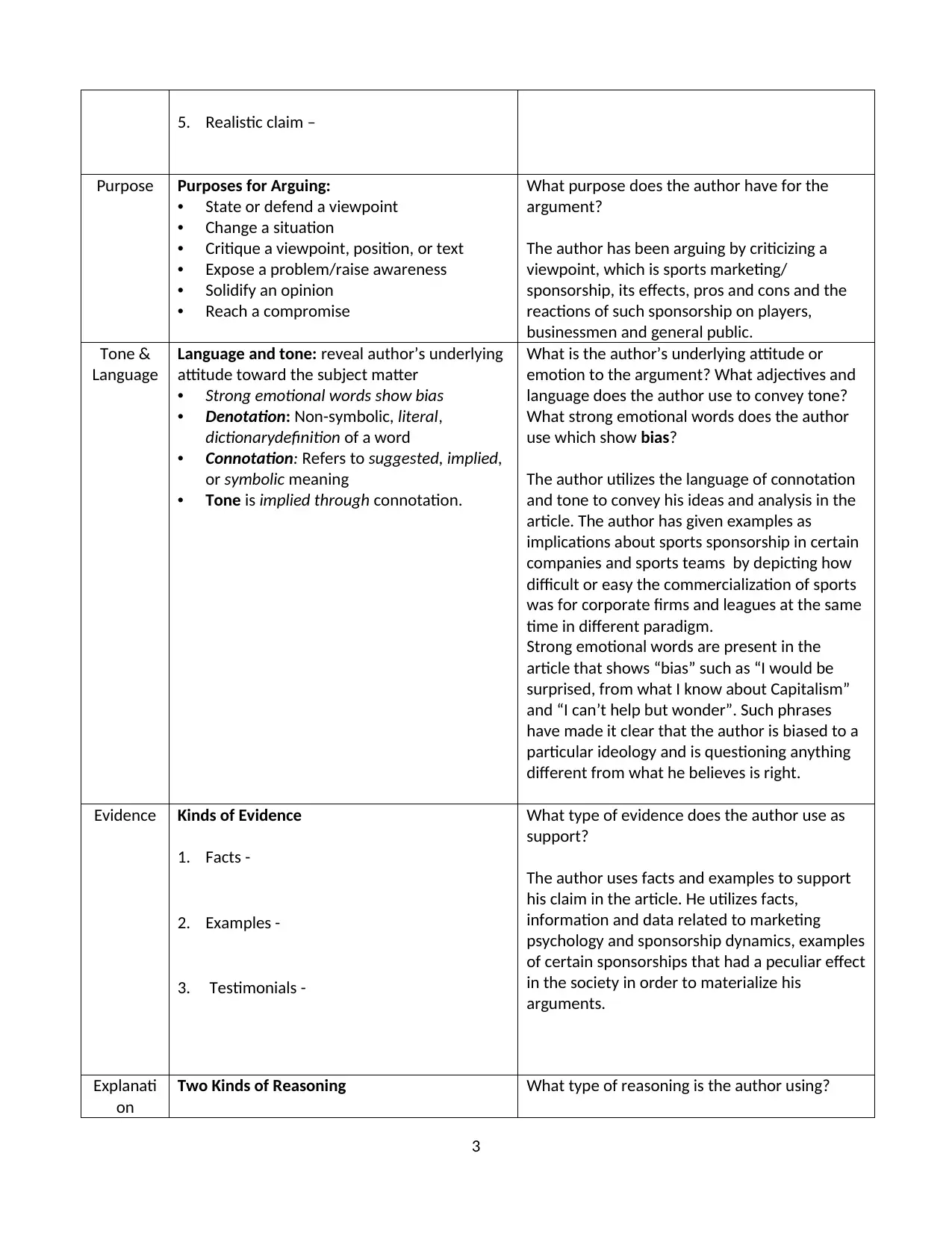
5. Realistic claim –
Purpose Purposes for Arguing:
• State or defend a viewpoint
• Change a situation
• Critique a viewpoint, position, or text
• Expose a problem/raise awareness
• Solidify an opinion
• Reach a compromise
What purpose does the author have for the
argument?
The author has been arguing by criticizing a
viewpoint, which is sports marketing/
sponsorship, its effects, pros and cons and the
reactions of such sponsorship on players,
businessmen and general public.
Tone &
Language
Language and tone: reveal author’s underlying
attitude toward the subject matter
• Strong emotional words show bias
• Denotation: Non-symbolic, literal,
dictionarydefinition of a word
• Connotation: Refers to suggested, implied,
or symbolic meaning
• Tone is implied through connotation.
What is the author’s underlying attitude or
emotion to the argument? What adjectives and
language does the author use to convey tone?
What strong emotional words does the author
use which show bias?
The author utilizes the language of connotation
and tone to convey his ideas and analysis in the
article. The author has given examples as
implications about sports sponsorship in certain
companies and sports teams by depicting how
difficult or easy the commercialization of sports
was for corporate firms and leagues at the same
time in different paradigm.
Strong emotional words are present in the
article that shows “bias” such as “I would be
surprised, from what I know about Capitalism”
and “I can’t help but wonder”. Such phrases
have made it clear that the author is biased to a
particular ideology and is questioning anything
different from what he believes is right.
Evidence Kinds of Evidence
1. Facts -
2. Examples -
3. Testimonials -
What type of evidence does the author use as
support?
The author uses facts and examples to support
his claim in the article. He utilizes facts,
information and data related to marketing
psychology and sponsorship dynamics, examples
of certain sponsorships that had a peculiar effect
in the society in order to materialize his
arguments.
Explanati
on
Two Kinds of Reasoning What type of reasoning is the author using?
3
Purpose Purposes for Arguing:
• State or defend a viewpoint
• Change a situation
• Critique a viewpoint, position, or text
• Expose a problem/raise awareness
• Solidify an opinion
• Reach a compromise
What purpose does the author have for the
argument?
The author has been arguing by criticizing a
viewpoint, which is sports marketing/
sponsorship, its effects, pros and cons and the
reactions of such sponsorship on players,
businessmen and general public.
Tone &
Language
Language and tone: reveal author’s underlying
attitude toward the subject matter
• Strong emotional words show bias
• Denotation: Non-symbolic, literal,
dictionarydefinition of a word
• Connotation: Refers to suggested, implied,
or symbolic meaning
• Tone is implied through connotation.
What is the author’s underlying attitude or
emotion to the argument? What adjectives and
language does the author use to convey tone?
What strong emotional words does the author
use which show bias?
The author utilizes the language of connotation
and tone to convey his ideas and analysis in the
article. The author has given examples as
implications about sports sponsorship in certain
companies and sports teams by depicting how
difficult or easy the commercialization of sports
was for corporate firms and leagues at the same
time in different paradigm.
Strong emotional words are present in the
article that shows “bias” such as “I would be
surprised, from what I know about Capitalism”
and “I can’t help but wonder”. Such phrases
have made it clear that the author is biased to a
particular ideology and is questioning anything
different from what he believes is right.
Evidence Kinds of Evidence
1. Facts -
2. Examples -
3. Testimonials -
What type of evidence does the author use as
support?
The author uses facts and examples to support
his claim in the article. He utilizes facts,
information and data related to marketing
psychology and sponsorship dynamics, examples
of certain sponsorships that had a peculiar effect
in the society in order to materialize his
arguments.
Explanati
on
Two Kinds of Reasoning What type of reasoning is the author using?
3
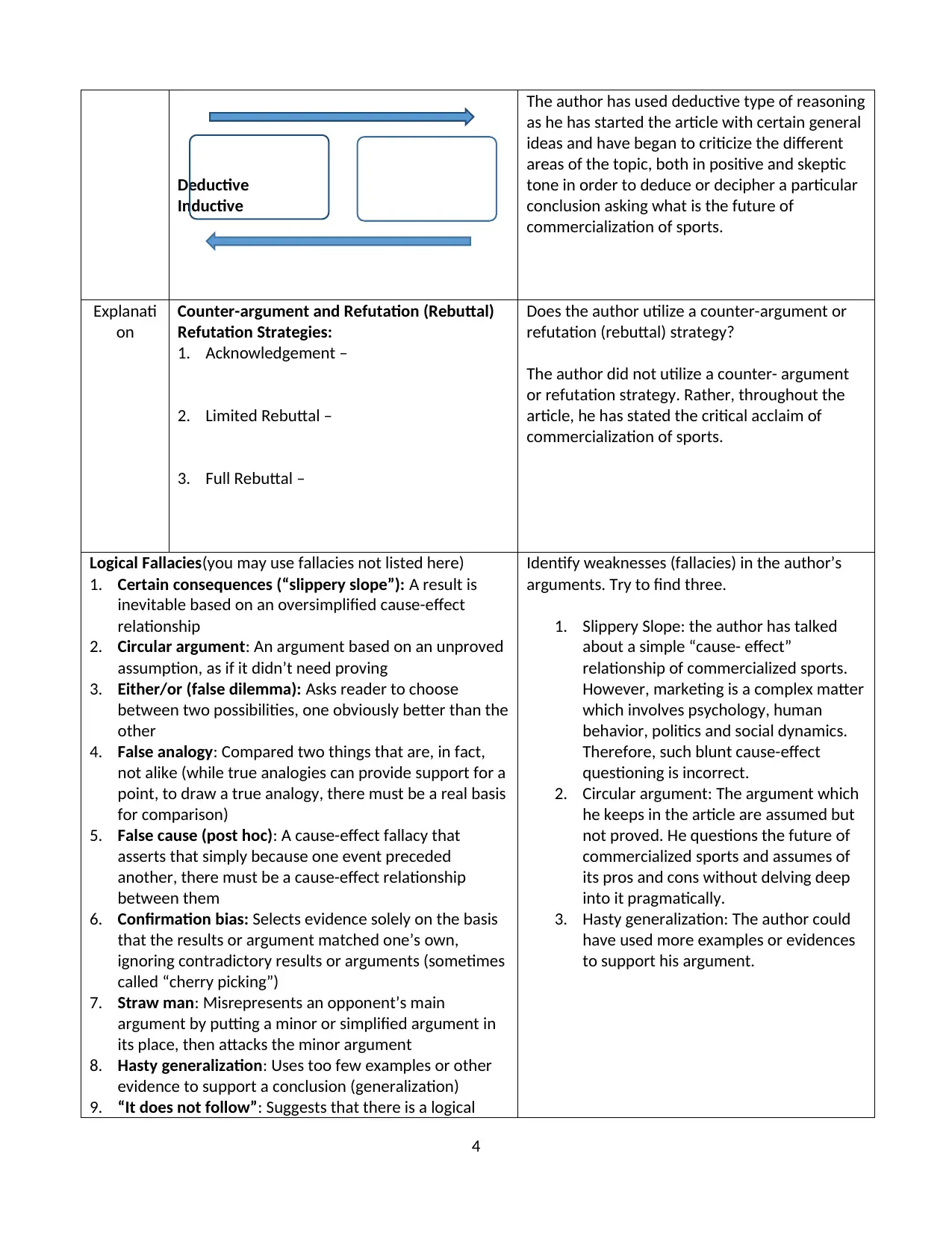
Deductive
Inductive
The author has used deductive type of reasoning
as he has started the article with certain general
ideas and have began to criticize the different
areas of the topic, both in positive and skeptic
tone in order to deduce or decipher a particular
conclusion asking what is the future of
commercialization of sports.
Explanati
on
Counter-argument and Refutation (Rebuttal)
Refutation Strategies:
1. Acknowledgement –
2. Limited Rebuttal –
3. Full Rebuttal –
Does the author utilize a counter-argument or
refutation (rebuttal) strategy?
The author did not utilize a counter- argument
or refutation strategy. Rather, throughout the
article, he has stated the critical acclaim of
commercialization of sports.
Logical Fallacies(you may use fallacies not listed here)
1. Certain consequences (“slippery slope”): A result is
inevitable based on an oversimplified cause-effect
relationship
2. Circular argument: An argument based on an unproved
assumption, as if it didn’t need proving
3. Either/or (false dilemma): Asks reader to choose
between two possibilities, one obviously better than the
other
4. False analogy: Compared two things that are, in fact,
not alike (while true analogies can provide support for a
point, to draw a true analogy, there must be a real basis
for comparison)
5. False cause (post hoc): A cause-effect fallacy that
asserts that simply because one event preceded
another, there must be a cause-effect relationship
between them
6. Confirmation bias: Selects evidence solely on the basis
that the results or argument matched one’s own,
ignoring contradictory results or arguments (sometimes
called “cherry picking”)
7. Straw man: Misrepresents an opponent’s main
argument by putting a minor or simplified argument in
its place, then attacks the minor argument
8. Hasty generalization: Uses too few examples or other
evidence to support a conclusion (generalization)
9. “It does not follow”: Suggests that there is a logical
Identify weaknesses (fallacies) in the author’s
arguments. Try to find three.
1. Slippery Slope: the author has talked
about a simple “cause- effect”
relationship of commercialized sports.
However, marketing is a complex matter
which involves psychology, human
behavior, politics and social dynamics.
Therefore, such blunt cause-effect
questioning is incorrect.
2. Circular argument: The argument which
he keeps in the article are assumed but
not proved. He questions the future of
commercialized sports and assumes of
its pros and cons without delving deep
into it pragmatically.
3. Hasty generalization: The author could
have used more examples or evidences
to support his argument.
4
Inductive
The author has used deductive type of reasoning
as he has started the article with certain general
ideas and have began to criticize the different
areas of the topic, both in positive and skeptic
tone in order to deduce or decipher a particular
conclusion asking what is the future of
commercialization of sports.
Explanati
on
Counter-argument and Refutation (Rebuttal)
Refutation Strategies:
1. Acknowledgement –
2. Limited Rebuttal –
3. Full Rebuttal –
Does the author utilize a counter-argument or
refutation (rebuttal) strategy?
The author did not utilize a counter- argument
or refutation strategy. Rather, throughout the
article, he has stated the critical acclaim of
commercialization of sports.
Logical Fallacies(you may use fallacies not listed here)
1. Certain consequences (“slippery slope”): A result is
inevitable based on an oversimplified cause-effect
relationship
2. Circular argument: An argument based on an unproved
assumption, as if it didn’t need proving
3. Either/or (false dilemma): Asks reader to choose
between two possibilities, one obviously better than the
other
4. False analogy: Compared two things that are, in fact,
not alike (while true analogies can provide support for a
point, to draw a true analogy, there must be a real basis
for comparison)
5. False cause (post hoc): A cause-effect fallacy that
asserts that simply because one event preceded
another, there must be a cause-effect relationship
between them
6. Confirmation bias: Selects evidence solely on the basis
that the results or argument matched one’s own,
ignoring contradictory results or arguments (sometimes
called “cherry picking”)
7. Straw man: Misrepresents an opponent’s main
argument by putting a minor or simplified argument in
its place, then attacks the minor argument
8. Hasty generalization: Uses too few examples or other
evidence to support a conclusion (generalization)
9. “It does not follow”: Suggests that there is a logical
Identify weaknesses (fallacies) in the author’s
arguments. Try to find three.
1. Slippery Slope: the author has talked
about a simple “cause- effect”
relationship of commercialized sports.
However, marketing is a complex matter
which involves psychology, human
behavior, politics and social dynamics.
Therefore, such blunt cause-effect
questioning is incorrect.
2. Circular argument: The argument which
he keeps in the article are assumed but
not proved. He questions the future of
commercialized sports and assumes of
its pros and cons without delving deep
into it pragmatically.
3. Hasty generalization: The author could
have used more examples or evidences
to support his argument.
4
Secure Best Marks with AI Grader
Need help grading? Try our AI Grader for instant feedback on your assignments.
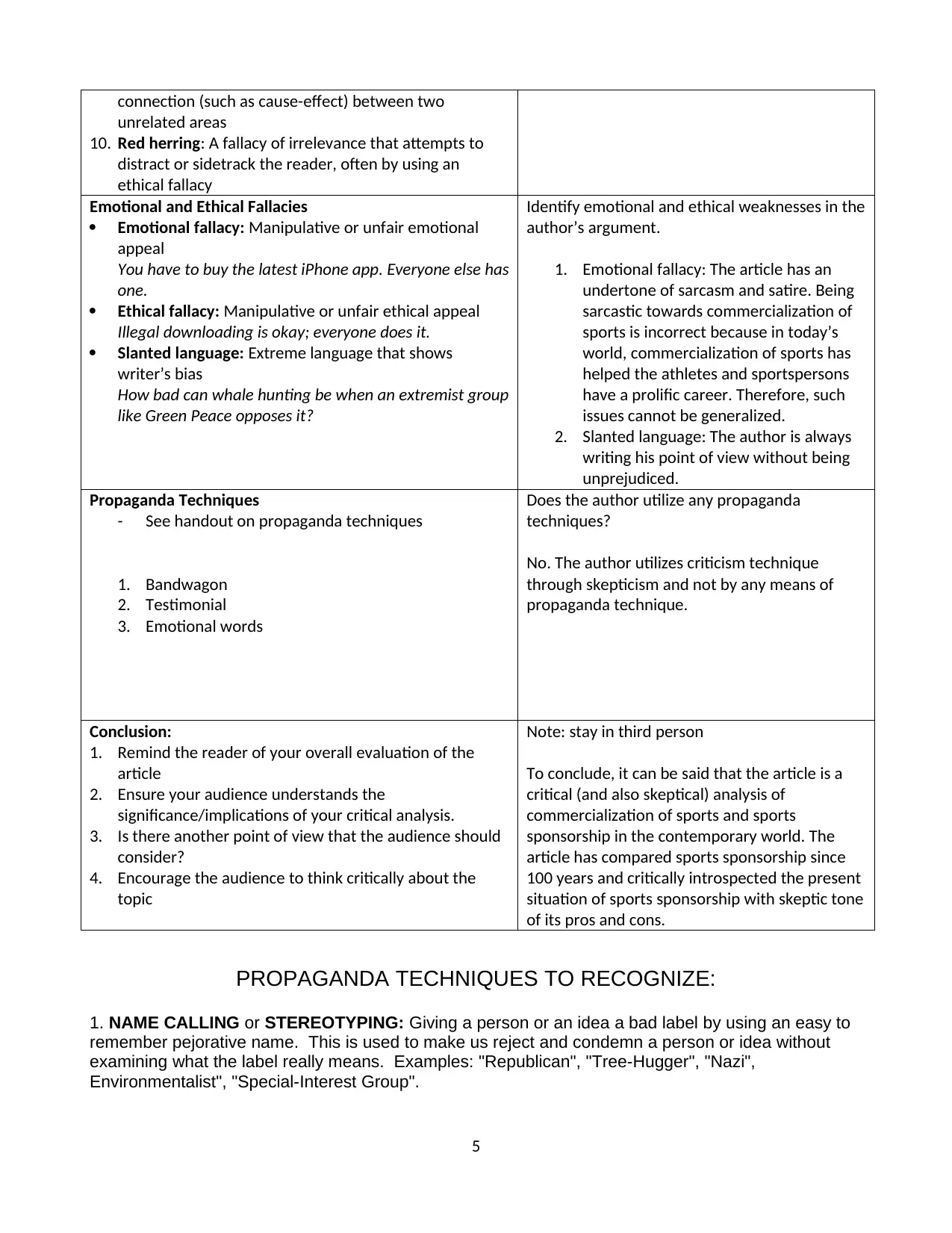
connection (such as cause-effect) between two
unrelated areas
10. Red herring: A fallacy of irrelevance that attempts to
distract or sidetrack the reader, often by using an
ethical fallacy
Emotional and Ethical Fallacies
Emotional fallacy: Manipulative or unfair emotional
appeal
You have to buy the latest iPhone app. Everyone else has
one.
Ethical fallacy: Manipulative or unfair ethical appeal
Illegal downloading is okay; everyone does it.
Slanted language: Extreme language that shows
writer’s bias
How bad can whale hunting be when an extremist group
like Green Peace opposes it?
Identify emotional and ethical weaknesses in the
author’s argument.
1. Emotional fallacy: The article has an
undertone of sarcasm and satire. Being
sarcastic towards commercialization of
sports is incorrect because in today’s
world, commercialization of sports has
helped the athletes and sportspersons
have a prolific career. Therefore, such
issues cannot be generalized.
2. Slanted language: The author is always
writing his point of view without being
unprejudiced.
Propaganda Techniques
- See handout on propaganda techniques
1. Bandwagon
2. Testimonial
3. Emotional words
Does the author utilize any propaganda
techniques?
No. The author utilizes criticism technique
through skepticism and not by any means of
propaganda technique.
Conclusion:
1. Remind the reader of your overall evaluation of the
article
2. Ensure your audience understands the
significance/implications of your critical analysis.
3. Is there another point of view that the audience should
consider?
4. Encourage the audience to think critically about the
topic
Note: stay in third person
To conclude, it can be said that the article is a
critical (and also skeptical) analysis of
commercialization of sports and sports
sponsorship in the contemporary world. The
article has compared sports sponsorship since
100 years and critically introspected the present
situation of sports sponsorship with skeptic tone
of its pros and cons.
PROPAGANDA TECHNIQUES TO RECOGNIZE:
1. NAME CALLING or STEREOTYPING: Giving a person or an idea a bad label by using an easy to
remember pejorative name. This is used to make us reject and condemn a person or idea without
examining what the label really means. Examples: "Republican", "Tree-Hugger", "Nazi",
Environmentalist", "Special-Interest Group".
5
unrelated areas
10. Red herring: A fallacy of irrelevance that attempts to
distract or sidetrack the reader, often by using an
ethical fallacy
Emotional and Ethical Fallacies
Emotional fallacy: Manipulative or unfair emotional
appeal
You have to buy the latest iPhone app. Everyone else has
one.
Ethical fallacy: Manipulative or unfair ethical appeal
Illegal downloading is okay; everyone does it.
Slanted language: Extreme language that shows
writer’s bias
How bad can whale hunting be when an extremist group
like Green Peace opposes it?
Identify emotional and ethical weaknesses in the
author’s argument.
1. Emotional fallacy: The article has an
undertone of sarcasm and satire. Being
sarcastic towards commercialization of
sports is incorrect because in today’s
world, commercialization of sports has
helped the athletes and sportspersons
have a prolific career. Therefore, such
issues cannot be generalized.
2. Slanted language: The author is always
writing his point of view without being
unprejudiced.
Propaganda Techniques
- See handout on propaganda techniques
1. Bandwagon
2. Testimonial
3. Emotional words
Does the author utilize any propaganda
techniques?
No. The author utilizes criticism technique
through skepticism and not by any means of
propaganda technique.
Conclusion:
1. Remind the reader of your overall evaluation of the
article
2. Ensure your audience understands the
significance/implications of your critical analysis.
3. Is there another point of view that the audience should
consider?
4. Encourage the audience to think critically about the
topic
Note: stay in third person
To conclude, it can be said that the article is a
critical (and also skeptical) analysis of
commercialization of sports and sports
sponsorship in the contemporary world. The
article has compared sports sponsorship since
100 years and critically introspected the present
situation of sports sponsorship with skeptic tone
of its pros and cons.
PROPAGANDA TECHNIQUES TO RECOGNIZE:
1. NAME CALLING or STEREOTYPING: Giving a person or an idea a bad label by using an easy to
remember pejorative name. This is used to make us reject and condemn a person or idea without
examining what the label really means. Examples: "Republican", "Tree-Hugger", "Nazi",
Environmentalist", "Special-Interest Group".
5
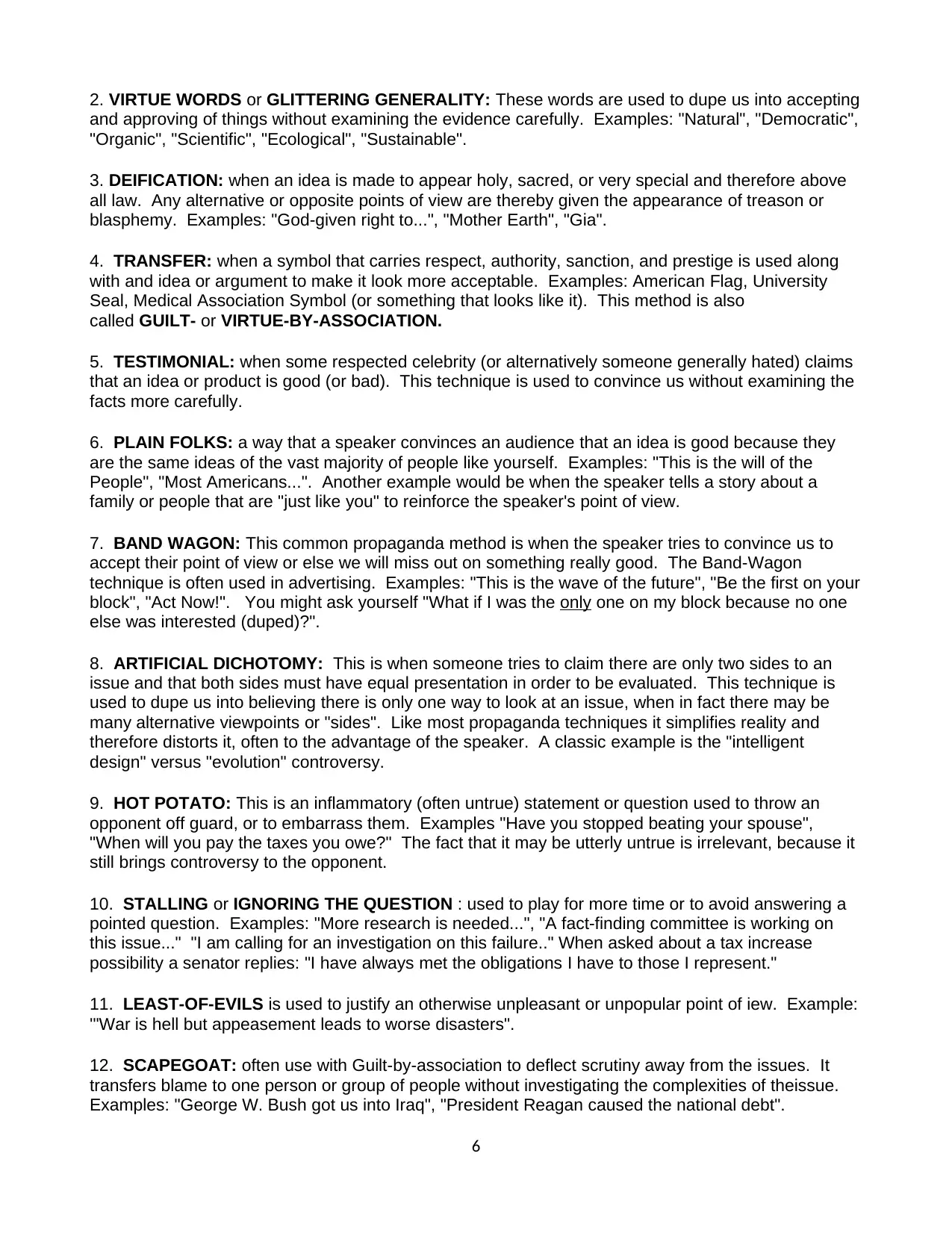
2. VIRTUE WORDS or GLITTERING GENERALITY: These words are used to dupe us into accepting
and approving of things without examining the evidence carefully. Examples: "Natural", "Democratic",
"Organic", "Scientific", "Ecological", "Sustainable".
3. DEIFICATION: when an idea is made to appear holy, sacred, or very special and therefore above
all law. Any alternative or opposite points of view are thereby given the appearance of treason or
blasphemy. Examples: "God-given right to...", "Mother Earth", "Gia".
4. TRANSFER: when a symbol that carries respect, authority, sanction, and prestige is used along
with and idea or argument to make it look more acceptable. Examples: American Flag, University
Seal, Medical Association Symbol (or something that looks like it). This method is also
called GUILT- or VIRTUE-BY-ASSOCIATION.
5. TESTIMONIAL: when some respected celebrity (or alternatively someone generally hated) claims
that an idea or product is good (or bad). This technique is used to convince us without examining the
facts more carefully.
6. PLAIN FOLKS: a way that a speaker convinces an audience that an idea is good because they
are the same ideas of the vast majority of people like yourself. Examples: "This is the will of the
People", "Most Americans...". Another example would be when the speaker tells a story about a
family or people that are "just like you" to reinforce the speaker's point of view.
7. BAND WAGON: This common propaganda method is when the speaker tries to convince us to
accept their point of view or else we will miss out on something really good. The Band-Wagon
technique is often used in advertising. Examples: "This is the wave of the future", "Be the first on your
block", "Act Now!". You might ask yourself "What if I was the only one on my block because no one
else was interested (duped)?".
8. ARTIFICIAL DICHOTOMY: This is when someone tries to claim there are only two sides to an
issue and that both sides must have equal presentation in order to be evaluated. This technique is
used to dupe us into believing there is only one way to look at an issue, when in fact there may be
many alternative viewpoints or "sides". Like most propaganda techniques it simplifies reality and
therefore distorts it, often to the advantage of the speaker. A classic example is the "intelligent
design" versus "evolution" controversy.
9. HOT POTATO: This is an inflammatory (often untrue) statement or question used to throw an
opponent off guard, or to embarrass them. Examples "Have you stopped beating your spouse",
"When will you pay the taxes you owe?" The fact that it may be utterly untrue is irrelevant, because it
still brings controversy to the opponent.
10. STALLING or IGNORING THE QUESTION : used to play for more time or to avoid answering a
pointed question. Examples: "More research is needed...", "A fact-finding committee is working on
this issue..." "I am calling for an investigation on this failure.." When asked about a tax increase
possibility a senator replies: "I have always met the obligations I have to those I represent."
11. LEAST-OF-EVILS is used to justify an otherwise unpleasant or unpopular point of iew. Example:
'"War is hell but appeasement leads to worse disasters".
12. SCAPEGOAT: often use with Guilt-by-association to deflect scrutiny away from the issues. It
transfers blame to one person or group of people without investigating the complexities of theissue.
Examples: "George W. Bush got us into Iraq", "President Reagan caused the national debt".
6
and approving of things without examining the evidence carefully. Examples: "Natural", "Democratic",
"Organic", "Scientific", "Ecological", "Sustainable".
3. DEIFICATION: when an idea is made to appear holy, sacred, or very special and therefore above
all law. Any alternative or opposite points of view are thereby given the appearance of treason or
blasphemy. Examples: "God-given right to...", "Mother Earth", "Gia".
4. TRANSFER: when a symbol that carries respect, authority, sanction, and prestige is used along
with and idea or argument to make it look more acceptable. Examples: American Flag, University
Seal, Medical Association Symbol (or something that looks like it). This method is also
called GUILT- or VIRTUE-BY-ASSOCIATION.
5. TESTIMONIAL: when some respected celebrity (or alternatively someone generally hated) claims
that an idea or product is good (or bad). This technique is used to convince us without examining the
facts more carefully.
6. PLAIN FOLKS: a way that a speaker convinces an audience that an idea is good because they
are the same ideas of the vast majority of people like yourself. Examples: "This is the will of the
People", "Most Americans...". Another example would be when the speaker tells a story about a
family or people that are "just like you" to reinforce the speaker's point of view.
7. BAND WAGON: This common propaganda method is when the speaker tries to convince us to
accept their point of view or else we will miss out on something really good. The Band-Wagon
technique is often used in advertising. Examples: "This is the wave of the future", "Be the first on your
block", "Act Now!". You might ask yourself "What if I was the only one on my block because no one
else was interested (duped)?".
8. ARTIFICIAL DICHOTOMY: This is when someone tries to claim there are only two sides to an
issue and that both sides must have equal presentation in order to be evaluated. This technique is
used to dupe us into believing there is only one way to look at an issue, when in fact there may be
many alternative viewpoints or "sides". Like most propaganda techniques it simplifies reality and
therefore distorts it, often to the advantage of the speaker. A classic example is the "intelligent
design" versus "evolution" controversy.
9. HOT POTATO: This is an inflammatory (often untrue) statement or question used to throw an
opponent off guard, or to embarrass them. Examples "Have you stopped beating your spouse",
"When will you pay the taxes you owe?" The fact that it may be utterly untrue is irrelevant, because it
still brings controversy to the opponent.
10. STALLING or IGNORING THE QUESTION : used to play for more time or to avoid answering a
pointed question. Examples: "More research is needed...", "A fact-finding committee is working on
this issue..." "I am calling for an investigation on this failure.." When asked about a tax increase
possibility a senator replies: "I have always met the obligations I have to those I represent."
11. LEAST-OF-EVILS is used to justify an otherwise unpleasant or unpopular point of iew. Example:
'"War is hell but appeasement leads to worse disasters".
12. SCAPEGOAT: often use with Guilt-by-association to deflect scrutiny away from the issues. It
transfers blame to one person or group of people without investigating the complexities of theissue.
Examples: "George W. Bush got us into Iraq", "President Reagan caused the national debt".
6
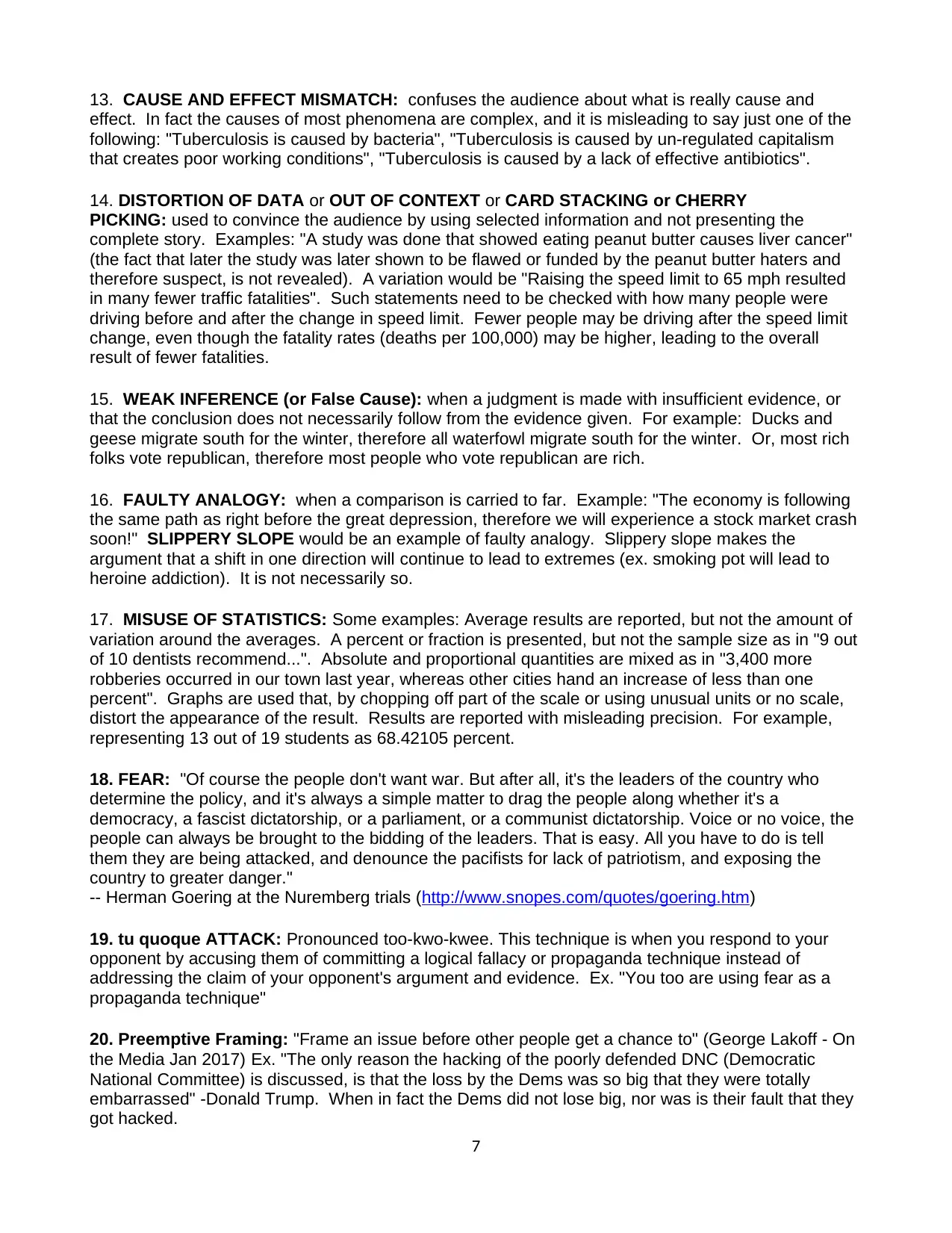
13. CAUSE AND EFFECT MISMATCH: confuses the audience about what is really cause and
effect. In fact the causes of most phenomena are complex, and it is misleading to say just one of the
following: "Tuberculosis is caused by bacteria", "Tuberculosis is caused by un-regulated capitalism
that creates poor working conditions", "Tuberculosis is caused by a lack of effective antibiotics".
14. DISTORTION OF DATA or OUT OF CONTEXT or CARD STACKING or CHERRY
PICKING: used to convince the audience by using selected information and not presenting the
complete story. Examples: "A study was done that showed eating peanut butter causes liver cancer"
(the fact that later the study was later shown to be flawed or funded by the peanut butter haters and
therefore suspect, is not revealed). A variation would be "Raising the speed limit to 65 mph resulted
in many fewer traffic fatalities". Such statements need to be checked with how many people were
driving before and after the change in speed limit. Fewer people may be driving after the speed limit
change, even though the fatality rates (deaths per 100,000) may be higher, leading to the overall
result of fewer fatalities.
15. WEAK INFERENCE (or False Cause): when a judgment is made with insufficient evidence, or
that the conclusion does not necessarily follow from the evidence given. For example: Ducks and
geese migrate south for the winter, therefore all waterfowl migrate south for the winter. Or, most rich
folks vote republican, therefore most people who vote republican are rich.
16. FAULTY ANALOGY: when a comparison is carried to far. Example: "The economy is following
the same path as right before the great depression, therefore we will experience a stock market crash
soon!" SLIPPERY SLOPE would be an example of faulty analogy. Slippery slope makes the
argument that a shift in one direction will continue to lead to extremes (ex. smoking pot will lead to
heroine addiction). It is not necessarily so.
17. MISUSE OF STATISTICS: Some examples: Average results are reported, but not the amount of
variation around the averages. A percent or fraction is presented, but not the sample size as in "9 out
of 10 dentists recommend...". Absolute and proportional quantities are mixed as in "3,400 more
robberies occurred in our town last year, whereas other cities hand an increase of less than one
percent". Graphs are used that, by chopping off part of the scale or using unusual units or no scale,
distort the appearance of the result. Results are reported with misleading precision. For example,
representing 13 out of 19 students as 68.42105 percent.
18. FEAR: "Of course the people don't want war. But after all, it's the leaders of the country who
determine the policy, and it's always a simple matter to drag the people along whether it's a
democracy, a fascist dictatorship, or a parliament, or a communist dictatorship. Voice or no voice, the
people can always be brought to the bidding of the leaders. That is easy. All you have to do is tell
them they are being attacked, and denounce the pacifists for lack of patriotism, and exposing the
country to greater danger."
-- Herman Goering at the Nuremberg trials (http://www.snopes.com/quotes/goering.htm)
19. tu quoque ATTACK: Pronounced too-kwo-kwee. This technique is when you respond to your
opponent by accusing them of committing a logical fallacy or propaganda technique instead of
addressing the claim of your opponent's argument and evidence. Ex. "You too are using fear as a
propaganda technique"
20. Preemptive Framing: "Frame an issue before other people get a chance to" (George Lakoff - On
the Media Jan 2017) Ex. "The only reason the hacking of the poorly defended DNC (Democratic
National Committee) is discussed, is that the loss by the Dems was so big that they were totally
embarrassed" -Donald Trump. When in fact the Dems did not lose big, nor was is their fault that they
got hacked.
7
effect. In fact the causes of most phenomena are complex, and it is misleading to say just one of the
following: "Tuberculosis is caused by bacteria", "Tuberculosis is caused by un-regulated capitalism
that creates poor working conditions", "Tuberculosis is caused by a lack of effective antibiotics".
14. DISTORTION OF DATA or OUT OF CONTEXT or CARD STACKING or CHERRY
PICKING: used to convince the audience by using selected information and not presenting the
complete story. Examples: "A study was done that showed eating peanut butter causes liver cancer"
(the fact that later the study was later shown to be flawed or funded by the peanut butter haters and
therefore suspect, is not revealed). A variation would be "Raising the speed limit to 65 mph resulted
in many fewer traffic fatalities". Such statements need to be checked with how many people were
driving before and after the change in speed limit. Fewer people may be driving after the speed limit
change, even though the fatality rates (deaths per 100,000) may be higher, leading to the overall
result of fewer fatalities.
15. WEAK INFERENCE (or False Cause): when a judgment is made with insufficient evidence, or
that the conclusion does not necessarily follow from the evidence given. For example: Ducks and
geese migrate south for the winter, therefore all waterfowl migrate south for the winter. Or, most rich
folks vote republican, therefore most people who vote republican are rich.
16. FAULTY ANALOGY: when a comparison is carried to far. Example: "The economy is following
the same path as right before the great depression, therefore we will experience a stock market crash
soon!" SLIPPERY SLOPE would be an example of faulty analogy. Slippery slope makes the
argument that a shift in one direction will continue to lead to extremes (ex. smoking pot will lead to
heroine addiction). It is not necessarily so.
17. MISUSE OF STATISTICS: Some examples: Average results are reported, but not the amount of
variation around the averages. A percent or fraction is presented, but not the sample size as in "9 out
of 10 dentists recommend...". Absolute and proportional quantities are mixed as in "3,400 more
robberies occurred in our town last year, whereas other cities hand an increase of less than one
percent". Graphs are used that, by chopping off part of the scale or using unusual units or no scale,
distort the appearance of the result. Results are reported with misleading precision. For example,
representing 13 out of 19 students as 68.42105 percent.
18. FEAR: "Of course the people don't want war. But after all, it's the leaders of the country who
determine the policy, and it's always a simple matter to drag the people along whether it's a
democracy, a fascist dictatorship, or a parliament, or a communist dictatorship. Voice or no voice, the
people can always be brought to the bidding of the leaders. That is easy. All you have to do is tell
them they are being attacked, and denounce the pacifists for lack of patriotism, and exposing the
country to greater danger."
-- Herman Goering at the Nuremberg trials (http://www.snopes.com/quotes/goering.htm)
19. tu quoque ATTACK: Pronounced too-kwo-kwee. This technique is when you respond to your
opponent by accusing them of committing a logical fallacy or propaganda technique instead of
addressing the claim of your opponent's argument and evidence. Ex. "You too are using fear as a
propaganda technique"
20. Preemptive Framing: "Frame an issue before other people get a chance to" (George Lakoff - On
the Media Jan 2017) Ex. "The only reason the hacking of the poorly defended DNC (Democratic
National Committee) is discussed, is that the loss by the Dems was so big that they were totally
embarrassed" -Donald Trump. When in fact the Dems did not lose big, nor was is their fault that they
got hacked.
7
Paraphrase This Document
Need a fresh take? Get an instant paraphrase of this document with our AI Paraphraser
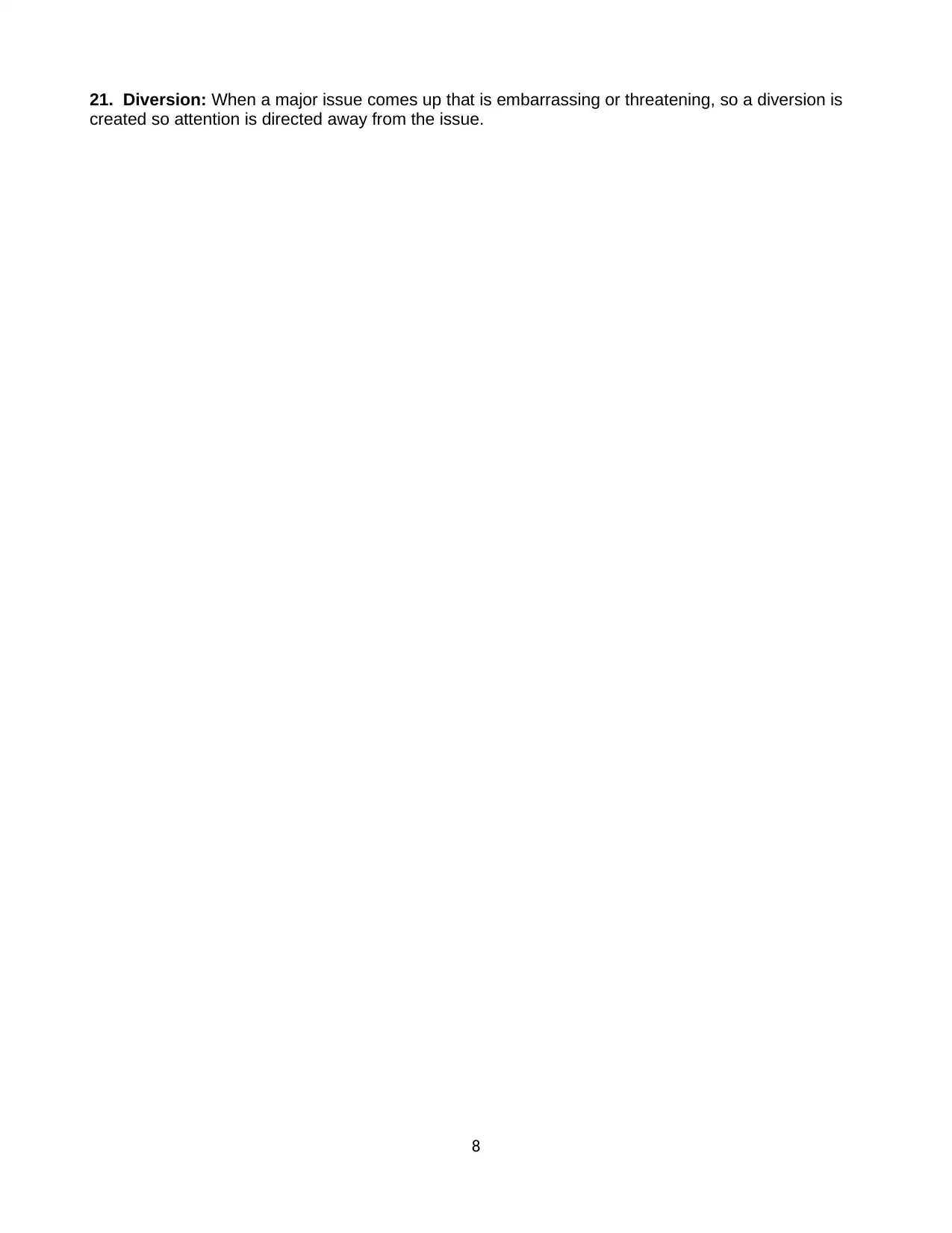
21. Diversion: When a major issue comes up that is embarrassing or threatening, so a diversion is
created so attention is directed away from the issue.
8
created so attention is directed away from the issue.
8
1 out of 8
Your All-in-One AI-Powered Toolkit for Academic Success.
+13062052269
info@desklib.com
Available 24*7 on WhatsApp / Email
![[object Object]](/_next/static/media/star-bottom.7253800d.svg)
Unlock your academic potential
© 2024 | Zucol Services PVT LTD | All rights reserved.

